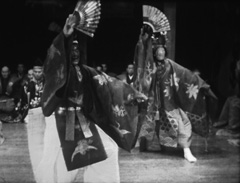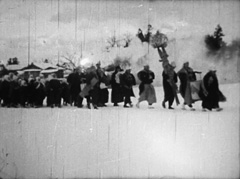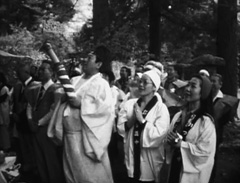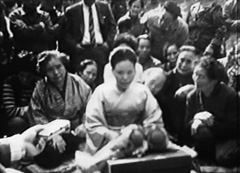Visual Folk History of Yamagata
A central theme of “Yamagata and Film” has been our use of historical footage to revisit Yamagata’s past. In line with this theme, this year we will be presenting documentary films showing performing arts and folk traditions passed down through the generations. Among these are arts that survive to this day, while there are also traditions that have long since become things of the past. There may be something that we can learn and take away from these films, something that hints at what separates the surviving traditions from those that fall by the wayside. Those who have memories of landscapes and traditions that no longer exist will most likely view these films with a sense of nostalgia, while the younger generation will look upon them with fresh eyes. We will use these perspectives to consider why the natural and cultural landscapes recorded in these films are disappearing from our lives, as we also explore the significance of the place that is Yamagata and the meaning that lies behind our documentation of the world around us.
 Kurokawa Noh
Kurokawa Noh
(kurokawa no)- 1954 / Japanese / B&W / Video (Original: 16mm) / 25 min
Production: Nihon University College of Art
Source: Yamagata Prefectural Education Institute
This film features a performance of Kurokawa Noh, a form of Noh theatre designated as an intangible cultural asset. Performed in the Kurokawa area of Kushibiki, a town in Yamagata’s Higashitagawa county that is now part of Tsuruoka City, Kurokawa Noh has a history spanning over 500 years. This film was produced in 1954 by the Nihon University College of Art and is a rare example of a Kurokawa Noh performance recorded shortly after the end of World War II.
 Ogisai Festival
Ogisai Festival
(Ogisai)- 1954 / Japanese / B&W / Video (Original: 16mm) / 21 min
Production: Nihon University College of Art
Source: Yamagata Prefectural Education Institute
Thought to have been filmed at the same time as Kurokawa Noh, this recording shows us the Ogisai Festival, a traditional festival of the Kurokawa area held on the 1st of February each year, lasting until the morning of the following day. This is a meticulous recording of a night that is at once quiet and riotous, and viewers will be ushered into a world of the subtle and profound.
 Ogare-Ogare
Ogare-Ogare
(Ogare ogare)- 1982 / Japanese / Color / Video (Original: 8mm) / 15 min
Director, Photography, Source: Kiyotaki Akira
This film captures an “ogare gathering” held in the Ginzan hot spring area of Obanazawa City. In the local dialect, “ogare” means “grow” or “become larger.” The recording shows a procession of smiling men who cry “Ogare! Ogare!” as they bear a shintai, or sacred object, crafted in the shape of a phallus. This is at once an enjoyable piece of viewing and a film of considerable historical value.
 Onakama
Onakama
(Onakama no furusato)- 1982 / Japanese / Color / Video (Original: 8mm) / 14 min
Director, Photography, Source: Kiyotaki Akira
Featured in this film is a group of “onakama” at an annual festival held in the Iwaya district of Nakayama Town. Onakama was one of the names given to a lineage of blind mediums that could be found throughout the Tohoku region, but the last of these mediums is now gone, and the Iwaya district itself is no more. This is an invaluable recording that allows us to revisit a lost time in our history.
